![]()
![]()
![]()
Use LEFT and RIGHT arrow keys to navigate between flashcards;
Use UP and DOWN arrow keys to flip the card;
H to show hint;
A reads text to speech;
16 Cards in this Set
- Front
- Back
- 3rd side (hint)
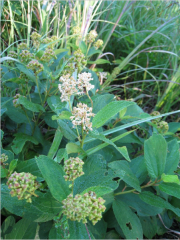
Inflorescences axillary |
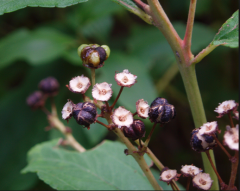
Ceanothus americanus and |
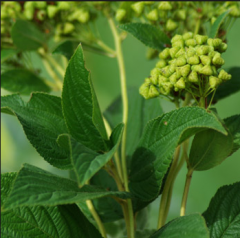
New Jersey Tea
Rhamnaceae
Dry open sandy plains and prairie-like areas (spreading to roadsides), dry savannas (with oak, aspen, pines); often in openings or transitional areas between lakes or marshes and forests; river banks. This species blooms much later than C. herbaceus, which will be in young fruit when C. americanus is flowering in any given area and season. Inflorescences in this species are typically from the uppermost nodes, with a small portion of the shoot or at least a conspicuous hairy bud extending beyond them. Only rarely (perhaps only as an abnormality or in late-season shoots) is there a truly terminal inflorescence, but this is then accompanied by a number of lateral inflorescences, these with long peduncles exceeding the subtending leaves. With only rare exceptions, the leaf blades are much broader than those of Ceanothus herbaceus. There is also a tendency for the leaves to be more broadly cuneate, or even truncate to subcordate at the base than in C. herbaceus, but this is much more variable and not always definitive. |
|
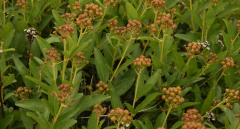
Inflorescences terminal on leafy branches |
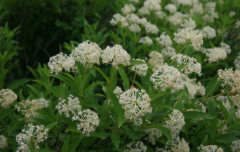
Ceanothus herbaceous |
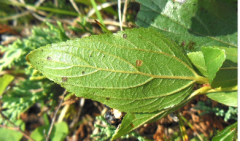
New Jersey Tea
Rhamnaceae
Jack pine plains, open rocky forests and outcrops, river and roadside banks, oak and other savannas. See notes under Ceanothus americanus. |
|
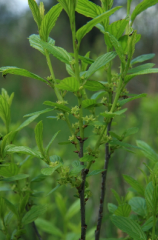
|
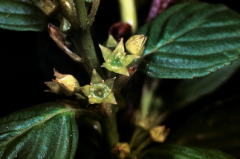
Rhamnus alnifolia |
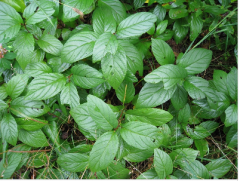
ALDER-LEAVED BUCKTHORN
Rhamnaceae
Fens, openings in tamarack and cedar (also sometimes spruce) swamps, peaty streamside thickets, interdunal swales, sedge marshes and mat, sometimes in wet, open deciduous forests, rocky openings and outcrops; generally a calciphile and a good indicator of fens. The leaf blades are of similar proportions to those of R. cathartica, but are more acute, may average a little larger, and have more pairs of lateral veins. These are strongly ascending and curve along the margins, much as in leaves of Cornus (which, however, are strictly entire). |
|

|
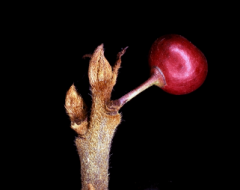
Frangula alnus* |
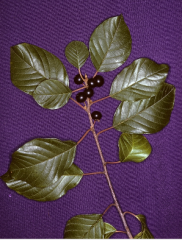
Glossy Buckthorn
Rhamnaceae
Rhamnus frangula of Michigan Flora. A Eurasian species, locally aggressive and becoming a major pest as a tall shrub in bogs, fens, and other wet habitats, including tamarack and cedar swamps (particularly in disturbed areas as along new power lines and other clearings), thickets along rivers, lake shores, ditches, fencerows; occasionally in drier sites. First collected in Michigan in 1934 in Delta Co. Frequently cultivated, now mostly as fastigiate cultivars ('Columnaris') with normal foliage, but strongly ascending branches, and fern leaf cultivars ('Asplenifolia') with a normal growth habit but a very narrow leaf with an irregular, wavy margin. Occasionally, weedy occurrences will contain variants that suggest their origins from these cultivars.
|
|

|
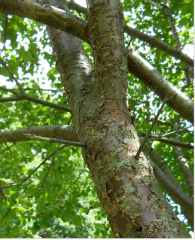
Rhamnus utilis* (much more rare)/ Rhamnus cathartica* |
Buckthorn/ common buckthorn
Rhamnaceae
An Asian species, locally established in old fields, thickets, and disturbed forests; first collected in 1980 in Washtenaw Co. When growing together with R. cathartica, the fruit is still green when that of neighboring R. cathartica is fully ripe. Hybrids with leaf shape intermediate between R. utilis andR. cathartica occur when the two grow together (Gil-ad & Reznicek, 1997). Some of these hybrids may resemble R. davurica Pall., which is a similar Asian species with elongated leaves, and is also recorded as an escape in the Great Lakes region, though not yet in Michigan. It differs in having only 3–4 pairs of main veins in the leaves and longer petioles.
R. cathartica : A Eurasian species, sometimes cultivated, and locally a weed, forming thickets in vacant lots, at borders of forests, along roadsides, fencerows, railroads, river banks, and clearings; occasionally in swamps. First collected in Michigan at Ann Arbor, Washtenaw Co., in 1914, but in the next two years recorded as plentiful and naturalized around Birmingham and Bloomfield Hills, Oakland Co. Now a pernicious weed, especially in forests near urban areas. |
|
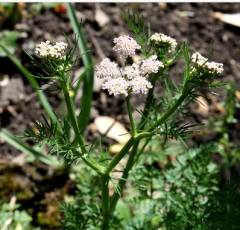
|
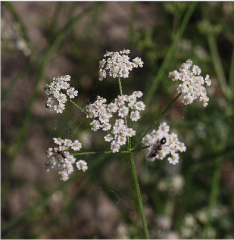
Carum carvi* |
Caraway Apiaceae
A Eurasian species, widely cultivated for its “seeds,” used for flavoring in rye bread and many other products. Locally established along roadsides and in fields, clearings, farmyards, shores, and disturbed places. First collected in 1883 in Keweenaw Co. Sometimes confused with Daucus carota, but blooms much earlier in the summer and lacks the conspicuous bracts at the base of the umbel. In addition, the leaves have sessile primary leaflets, while in Daucus, the primary leaflets are petiolulate. The rays of the umbel are quite unequal in length and are ± strongly ascending in fruit. |
|

|
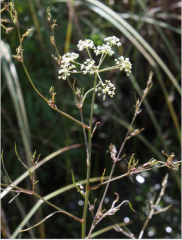
Cicuta bulbifera |

Water Hemlock Apiaceae
Marshes and shores, borders of lakes and streams, bogs and tamarack swamps, swales and ditches, moist thickets and river margins. This species is supposedly less poisonous than C. maculata, but nevertheless toxic if ingested. |
|
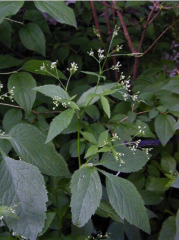
|
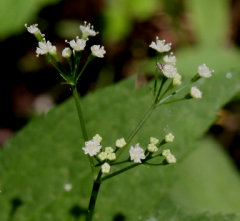
Cryptotaenia canadensis |

Honewort Apiaceae
Beech-maple and other rich forests; swamps. |
|

|
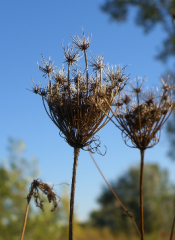
Daucus carota* |
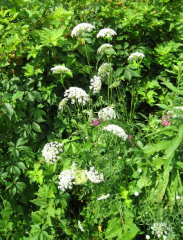
Wild carrot Apiaceae
An Old World native, now a well established weed of disturbed places, roadsides, and fields, also invading shores, and other open habitats. First collected in 1886 in Kent Co. The garden carrot, with enlarged, orange, brittle roots, is derived from this complex and variable species, and may be called D. carota var. sativus Hoffman or subsp. sativus(Hoffm.) Arcang. Wild carrots have whitish, often branched, relatively slender and tough roots; they may smell like carrots, and are not poisonous, but they are unpalatable. There is usually a dark purple flower in the center of each inflorescence, and very rarely all the corollas are pink or purple. Green flowered variants have also been observed. See also notes under Carum carvi. |
|
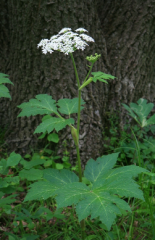
|
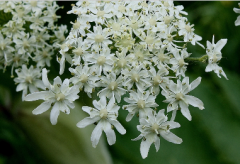
Heracleum maximum |
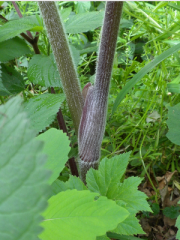
cow parsnip apiaceae
Floodplains and river banks, wet meadows and thickets; open hardwoods and clearings (spruce-fir at Isle Royale), borders of forests. Individuals are often as tall as 2 m, with broad (at most ± 20 cm) flat-topped, white-flowered umbels, and are a striking sight. |
|
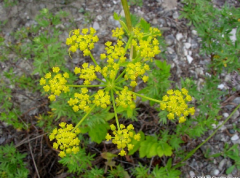
|

Pastinaca sativa* |
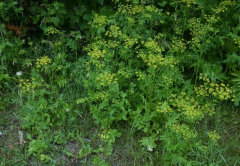
Wild parsnip apiaceae
A Eurasian native, very well established (though usually ignored by collectors) throughout Michigan. Moist to dry roadsides, fields, clearings, shores; invading open forests and thickets. First collected in 1871 in Wayne Co., but found in the 1880’s in counties as far apart as Keweenaw, Emmet, and Ingham. Though no collections are known, the species was listed by the First Survey, so presumably it was in the state as early as 1838. The common weed has presumably (in part, at least) reverted to the wild from cultivation, where strains are grown for their fleshy whitish edible roots. “Wild” plants have the same parsnip odor; the root is not poisonous to eat, despite a dubious reputation, but the foliage may be a serious skin irritant in sensitive people. The stems in this species are deeply furrowed and strongly angled. Very depauperate specimens may have leaves with only 3 leaflets. |
|
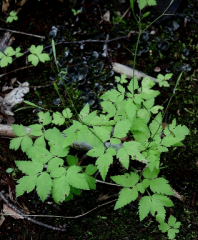
|
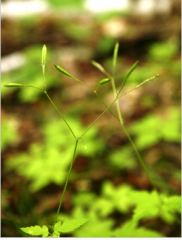
Osmorhiza berteroi |

Sweet cicely apiaceae
Deciduous (beech-maple and northern hardwood), mixed, and coniferous forests and thickets, frequently on thin soil over limestone or other rock, or along trails. Often growing with O. claytonii and O. longistylis. Originally described from Chile, this species is, like O. depauperata, disjunct to North America; and it is also a classic disjunct between western North America, the Black Hills, the northern Great Lakes region, and the east (Newfoundland to New Hampshire). Kartesz and Gandhi (1993) note that the name O. berteroi has priority over O. chilensis. The bruised roots often have at least a weak licorice odor. |
|
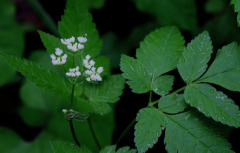
|
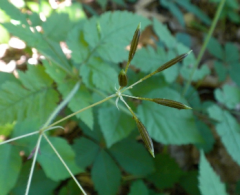
Osmorhiza claytonii |
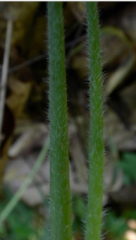
Hairy sweet-cicely apiaceae
Deciduous forests, including beech-maple, oak and oak-hickory, northern hemlock-hardwoods; very rarely in strictly coniferous forests; sometimes on rocky or alluvial sites; persistent after clearing. Much more common thanO. longistylis, and often in drier sites. Rarely a plant of O. longistylis with very young flowers will have styles less than 1.5 mm long, but such can be distinguished from O. claytonii by the congested umbellets with broader bractlets in the involucels, as well as generally longer petals and licorice odor. |
|
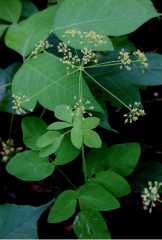
|

Taenidia integerrima |

Yellow Pimpernel Apiaceae
Jack pine plains and other sandy (or rocky), savannas on plains or low dunes, with oak, pines, and/or aspen; deciduous forests, especially along borders and in openings; river- and stream-bank thickets. An easily recognized, smooth (even glaucous) species, our only umbellifer with yellow flowers and strictly entire leaflets.
|
|

|
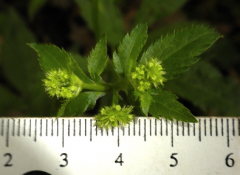
Sanicula canadensis |
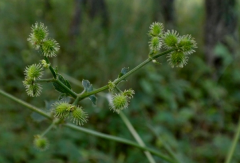
Black Snakeroot Apiaceae
Deciduous forests and thickets. The long-styled Sanicula canadensis var. grandis Fernald (see Pryer & Phillippe, 1989) is known from southern Ontario, but no Michigan specimens have been seen thus far. |
|

|
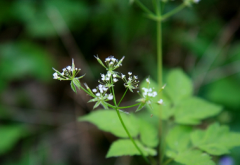
Osmorhiza longistylis |
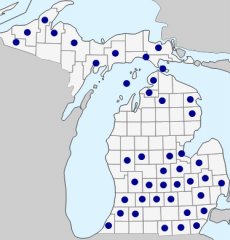
Smooth Sweet-cicely Apiaceae
Rich, often moist (even swampy) deciduous forests; persistent after clearing and hence sometimes in fine stands along forest roads. Frequently growing with O. claytonii, but usually restricted to rich moist sites. Ordinarily one can readily distinguish this species in the field from O. claytonii by its taller, stiffer habit with redder, more glabrous stems; the flowers tend to be larger (petals often ca. 1.5–2.2 mm long, at least on bisexual flowers) and, as they are more numerous in the umbellets (due mostly to a larger number of staminate ones), the plant is more showy. Bracts of the involucel tend to be broader than in O. claytonii (often over 1 mm). Rarely the stem is densely villous (var. villicaulis Fernald). Bruised foliage of O. longistylis has a licorice odor, while that of O. claytonii has a carrot-like odor. |

